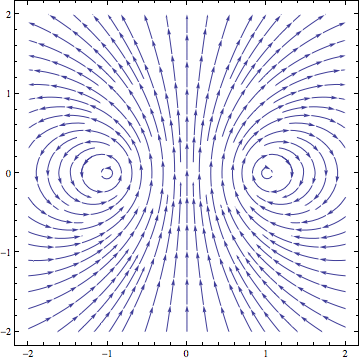The integrals can in fact be done exactly, but only if you make some use of the symmetries of the problem first.
- The circular ring geometry implies that the magnetic field will look the same in any vertical plane going through the rotation axis (which we call the
zaxis). Therefore, we don't need to specify three independent variablesx,yandzto do the calculation. Instead, sety = 0and look only at thexzplane. - The component of the magnetic field perpendicular to the
xzplane must be zero, so we don't have to calculate the integral for it. - Use spherical polar coordinates to specify the point of interest, instead of Cartesian coordinates
- In the non-zero integrals over the ring, the integration variable
Thetaappears only in the formCos[Theta]which is symmetric aroundTheta = π. Therefore, all integrals can be reduced to the domain{Theta, 0, π}if we multiply the result by2at the end.
With these points in mind, the calculation goes like this (using exactly your setup): replace the Integrand by int2 which uses spherical coordinates with the azimuthal angle set to zero (xz plane), then observe that we only need to integrate int[[1]] and int[[3]] to get Bx and Bz:
s = 1;
m = 4*Pi*10^7;
l[Theta_] := {s Cos[Theta], s Sin[Theta], 0};
R = {x, y, z} - l[Theta];
r = R/Sqrt[R.R];
Deel = D[l[Theta], Theta];
Cross[Deel, r];
Integrand = %/R.R;
int2 = Simplify[
Integrand /.
Thread[{x, y,
z} -> ρ {Cos[ϕ] Sin[θ],
Sin[ϕ] Sin[θ], Cos[θ]} /. ϕ ->
0], ρ > 0 && θ > 0 && ϕ > 0 && Theta > 0]
$$\left\{\frac{\rho \cos (\theta ) \cos (\text{Theta})}{\left(\rho ^2-2 \rho \sin (\theta ) \cos (\text{Theta})+1\right)^{3/2}},\\ \frac{\rho \cos (\theta ) \sin (\text{Theta})}{\left(\rho ^2-2 \rho \sin (\theta ) \cos (\text{Theta})+1\right)^{3/2}},\\ \frac{1-\rho \sin (\theta ) \cos (\text{Theta})}{\left(\rho ^2-2 \rho \sin (\theta ) \cos (\text{Theta})+1\right)^{3/2}}\right\}$$
Bx =
2 Assuming[ρ > 0 && Pi/2 > θ > 0,
Integrate[int2[[1]], {Theta, 0, Pi}]]
$$\frac{2 \cot (\theta ) \left(\left(\rho ^2+1\right) E\left(\frac{4 \rho \sin (\theta )}{\rho ^2+2 \sin (\theta ) \rho +1}\right)-\left(-2 \rho \sin (\theta )+\rho ^2+1\right) K\left(\frac{4 \rho \sin (\theta )}{\rho ^2+2 \sin (\theta ) \rho +1}\right)\right)}{\left(-2 \rho \sin (\theta )+\rho ^2+1\right) \sqrt{2 \rho \sin (\theta )+\rho ^2+1}}$$
Bz =
2 Assuming[ρ > 0 && Pi/2 > θ > 0,
Integrate[int2[[3]], {Theta, 0, Pi}]]
$$\frac{2 \left(\left(-2 \rho \sin (\theta )+\rho ^2+1\right) K\left(\frac{4 \rho \sin (\theta )}{\rho ^2+2 \sin (\theta ) \rho +1}\right)-\left(\rho ^2-1\right) E\left(\frac{4 \rho \sin (\theta )}{\rho ^2+2 \sin (\theta ) \rho +1}\right)\right)}{\left(-2 \rho \sin (\theta )+\rho ^2+1\right) \sqrt{2 \rho \sin (\theta )+\rho ^2+1}}$$
Here, $E$ and $K$ are the elliptic functionsintegrals EllipticE and EllipticK.
StreamPlot[{Bx,
Bz} /. {θ -> ArcTan[z, x], ρ -> Sqrt[
x^2 + z^2]}, {x, -2, 2}, {z, -2, 2}]

This is a plot of the exact result.
